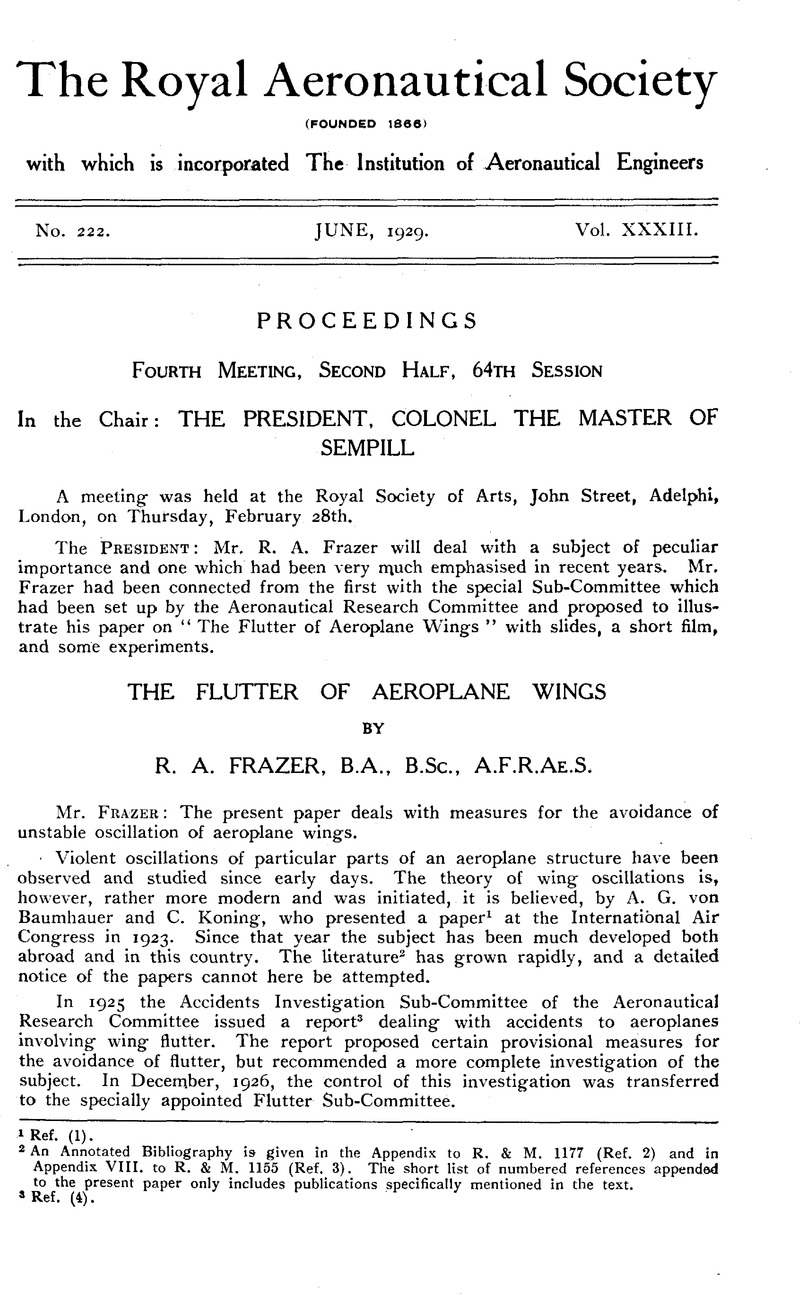Published online by Cambridge University Press: 28 July 2016

1 Ref. (1).
2 An Annotated Bibliography is given in the Appendix to R. & M. 1177 (Ref. 2) and in Appendix VIII. to R. & M. 1155 (Ref. 3). The short list of numbered references appended to the present paper only includes publications specifically mentioned in the text.
Ref. (4).
4 Ref. (3).
5 Multiple frequencies can sometimes be induced by reflections of oscillations along bracing wires. Such effects are merely secondary.
6 Ref. (5).
7 On a staggered biplane, for example, some “ yawing ” movements of each wing would occur during flutter, and additional co-ordinates might be necessary to describe the displacements.
8 Flutter would occur if one of the oscillations were negatively damped, but this objectionable contingency is believed to be unlikely with full-sized wings at ordinary angles of incidence.
9 See end of §1.
10 In certain simplified treatments of the subject compound dampings are neglected entirely. If they were actually absent, the points M and N of Fig. 2 would both coincide with the origin O. The point Z would now lie above the ellipse, and flutter could readily be prevented.
11 The product of inertia coefficients appropriate to curves Nos. 1, 2, 3 are 0.033, 0.015 and zero, respectively, in Fig. 3, and 0.024, 0.006 and zero, respectively, in Fig. 4.
12 The formulae for the wind speed V corresponding to any point Q of the diagram are stated in Fig. 2. The flexural stiffness is defined as the load per unit linear deflection, multiplied by the square of the wing span; and the torsional stiffness as the twisting couple per radian angle of twist. The loads are to be applied, and the deflections measured, at the wing tip.
Numerical example :— p = 0.00237 slug/ft.3; S = 75 ft.2; s = 15ft.; flexural stiffness = 1.5xl06 lb. ft. per radian; stiffness ratio 1:20; flexural centre at 0.25 chord; principal centre of inertia at 0.54 chord.
Then the critical speed for flutter is given by the intersection Q1 shown in Fig. 3; and on application of the formulas of Fig. 2, the critical speed is found to be Vc = 440 m.p.h. If the principal centre of inertia had been at 0.38 chord (intersection Qn), the critical speed would have been raised to 510 m.p.h. The critical speed corresponding to curve No. 3 would be extremely high.
These results are only applicable if the moment of inertia coefficients of the wing are those appropriate to the diagram. With the particular dimensions and stiffnesses cited, the natural frequencies of the wing in flexure and in torsion for still air would necessarily be 815 and 1360 cycles per minute, respectively.
13 A very flexible aileron would clearly be liable to flutter on its own account in flexure and torsion.
14 The relevant formulae for wind speed are obtained from those for Figs. 3 and 4 by substitution of the aileron elastic stiffness for the flexural stiffness. The aileron elastic stiffness is measured as the elastic hinge moment per radian aileron angle. In both Figs. 5 and 6 the torsional moment of inertia coefficient of the wing is 0.0041 (as for Fig. 4).
Numerical example.—Wing dimensions, etc., as in footnote 12, and torsional wing stillness. 0.75 x105:
(a) C.G. at 0.25 aileron chord behind hinge axis (Curve No. 1 of Fig. 5). Aileron free (Intersection Q1) V0 = 270 m.p.h. 50:1 stiffness ratio (Intersection Q1 1) Vc = 305 m.p.h.
(b) C.G. on hinge axis (Curve No. 2). Aileron free (Intersection Q2) 70 = 340 m.p.h. 50:1 stiffness ratio (Intersection Q1 2.) Vc = 245 m.p.h.
(c) C.G. near aileron leading edge (Curve No. 3 and divergence hyperbola). No flutter, but divergence speed of over 680 m.p.h.
15 The position of the points depend solely upon the dampings and the compound wind stiffnesses.
16 By means of an electrically maintained tuning fork 50 interruptions per second were obtained.
17 The true flexural and torsional displacements of the wing, and the angular movements of the aileron, could readily be deduced.
18 Shape specified as Section “ A ” in Table I. of R. & M. 681.
19 The test illustrates a condition where both intersections of a stiffness line with a test-conic correspond to flutter. Clearly, not more than two such intersections can occur.
20 At 57.8 ft./sec. the flexural elastic damping was 2 per cent, of the flexural wind damping, and the torsional elastic damping was 10 per cent, of the torsional wind damping.
21 It is important to note that the moments and the products of inertia of a wing-aileron system would be different, according as they were measured in vacuo or in still air. The values in vacuo would agree with the constants as calculated from the masses of the wing or the aileron; whereas the values in still air would include a “ virtual ” inertial constant, representing the influence of the air masses disturbed. These “ virtual ” inertias may sometimes become quite significant, and in flutter theory they should always be included as part of the inertial constants. For this reason, experimentally determined inertias are preferable to calculated values.
22 Elastic wing damping is ignored.
23 The divergence speeds are similarly connected.
24 i.e., to motions such that the forces acting are merely multiples of acceleration, velocity, or displacement.
25 For instance, yawing displacements of one wing may result from normal displacements of the other.
26 List of recommendations reproduced almost verbatim from R. & M. 1155.
27 This recommendation is due to Mr. R. V. Southwell, F.R.S.
28 Some experiments on the model of 27in. span confirm the advantages of staying as suggested.